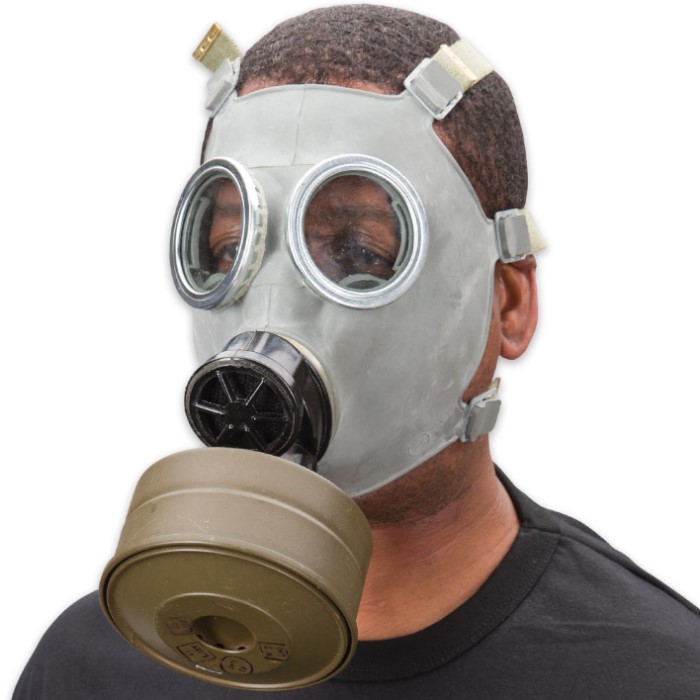

The FASER company has proved that MC-1 was produced using 4 different faceblanks. In earlier versions of those appliances a GSP-M or an Ma-1 / Ma-1M was included. MC-1 was a part of all open circuit isolating apparatusses made in Poland, that is: AZ-2M, AT-4M, AJ-3M and AS-3M. In industry it was used with P22/1-w and other types of filters or FP-203 and FW-2131 filters but the original industrial kit did not come with any filters. In the mid-90s, the earlier filters were replaced with P-5 filters. MC-1 was issued to civil defense with MS-3 and MS-4 filters. The filter that comes with the mask was a light grey GOST canister known as the MS-4. The plastic disc is thin and slightly translucent. The exhale valve housing contains a metal mesh covering it, it also has a thin plastic disc behind the metal mesh. Air enters the mask via Tissot tubes and exits through the exhale valve. The eyepieces are glass, held on with crimped metal and fabric. Whereas the MC-1 has a black plastic inlet/exit valve assembly and an olive green fabric 6 point headstrap. The original CM-3 has the inlet/exit valve out of brown bakelite. If this is the case, then you’ll need to smooth the damaged surface using a fine grit sanding block designed specifically for paintwork, or potentially a buffer if the damage is particularly bad.It was made from olive-tan rubber. You may need to apply a filler if your car’s bodywork has been damaged. If the damage to your car goes beyond superficial damage, then the repair jobs becomes a little more complex. T-Cut may take some times to cure, so try to fix the scratch in good weather conditions and try to avoid driving for 24 hours or so. Then, apply the T-Cut or scratch solution to the scratch. Grab a very light grit abrasive pad suitable for repairing paintwork and clean away any rough edges.
#Polish gas mask repair kit code
Remember, you’ll need to know the exact name or code for your car’s paint to be able to get the right match, so check your car’s documents or look for a code in the glove box or inside the wheel well. Scratch repair fluids like T-Cut are often the best solution, as they’ll not fill the scratch as well as providing a suitable colour match. If you can feel the scratch, or can see that it has gone down to the primer or metal, then you’ll need a more comprehensive solution. If you feel confident, or already have a polisher, then you can use this to remove surface scratches. Grab a fine cloth and some clear polish and start buffing the scratch. To find out if the scratch is light, run a finger over it – if you can’t feel it, then it can be polished. Light scratches on the surface of the paintwork can usually be fixed by polishing. The right product for your type of damage (see sections below).Here’s our guide to getting those nasty blemishes removed from your bodywork yourself, so you save money on an expensive fix and enjoy a smooth, scratch-free car once again.
#Polish gas mask repair kit drivers
There’s nothing worse than spotting a scratch, flaking or scuffs on your shiny bodywork – and it always seems to be careless drivers bashing their doors into your dream machine!įixing scratches and chips should be a common job for many motorists, but many choose to leave it to the professionals or just not bother to fix them at all.


 0 kommentar(er)
0 kommentar(er)
